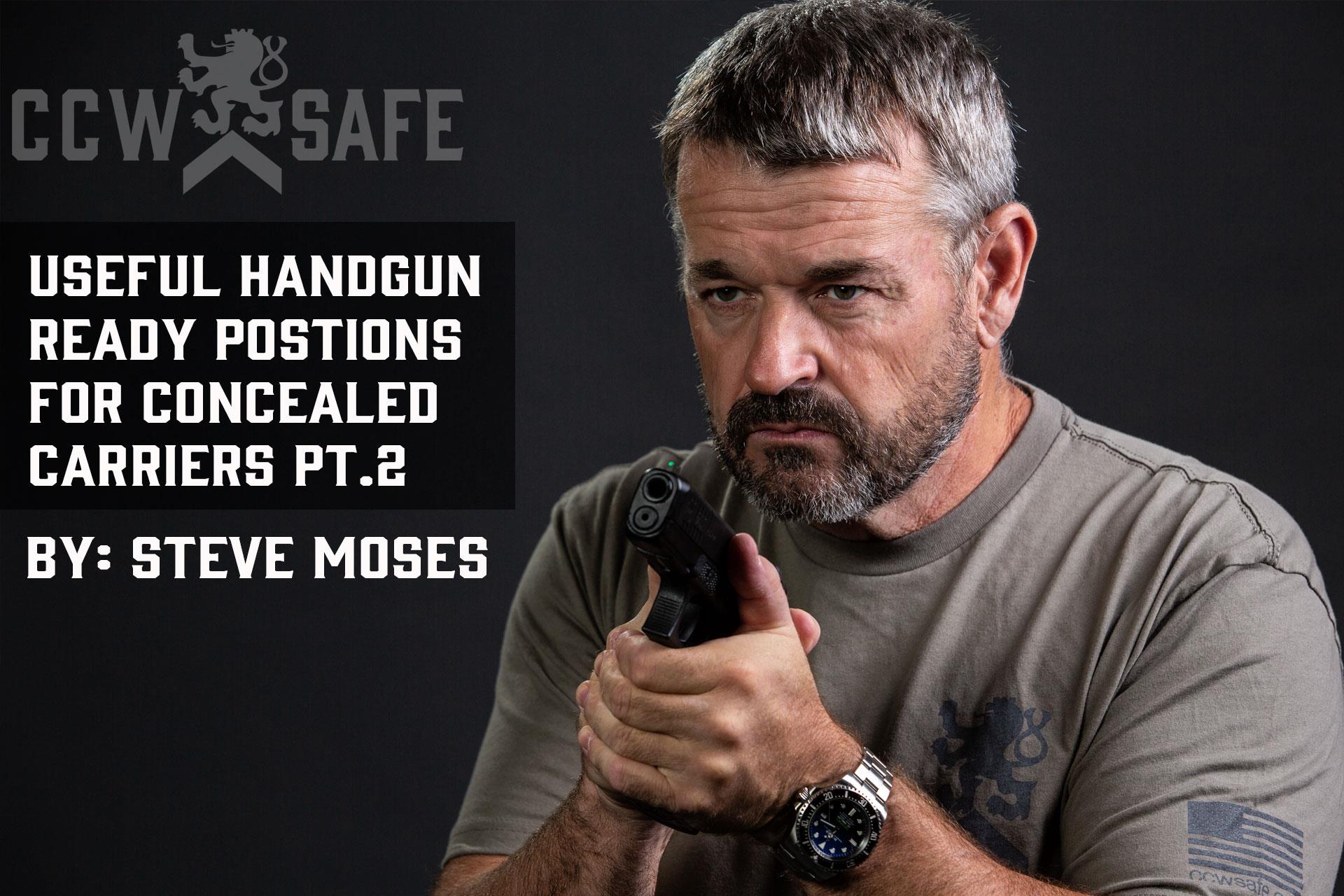
Posted on December 28, 2020
USEFUL HANDGUN READY POSITIONS FOR CONCEALED CARRIERS PT.2
USEFUL HANDGUN READY POSITIONS FOR CONCEALED CARRIERS PT.2
Part One of this article discussed why knowing how to choose and properly use an effective handgun ready position was important for concealed carriers. Part Two of this article addresses three more ready positions and concludes with three observations that I think concealed carriers should be aware of.
- LOW READY: I have established a strong two-handed grip on the handgun and projected the muzzle out at a downward angle of 45 degrees or more dependent upon the distance between myself and a potentially dangerous contact. I do not want the muzzle pointing at my feet and I do not want the muzzle pointing at their feet (or higher). If I am using this position it is because I possess a legitimate and articulable fear for my life or someone else’s and I believe that nothing less than the threat of or actual use of deadly force is sufficient, and I am far enough away that another person would have to move a significant distance before they could get close enough to me to grab my handgun. I prefer not to actually point the muzzle at any part of another person when using this position. I can still quickly get the muzzle on target and get accurate hits if need be, and I am not pointing the muzzle at an object that might be destroyed, damaged, injured, or killed in accordance with one of the four primary firearm safety rules.
- HIGH READY: I did not really come to appreciate this position until I attended a recent Dave Spaulding class and learned that I had been performing it incorrectly (which is probably the reason that I was not a fan before). Done correctly, the concealed carrier establishes a strong two-handed grip on the handgun, pins the tips of his or her elbows to the torso, and rotates the handgun upward until such time that he or she can see the entire top of the front sight. Establishing repeatable index points like this eliminated much of my concern about the validity of this position for concealed carriers as it is nearly impossible to point the muzzle at another person standing at ground level if done properly. This is most likely not a good choice for use around elevated areas where there could be people present. This is not a position that would be my first choice for use in a public area UNLESS there is a good reason that pointing the muzzle downward is dangerous for reasons outside of my control. This could include the presence of small children, close proximity of seated persons, or even the fact that I am seated at the time.
- TEMPLE INDEX POSITION: The Temple Index position calls for the concealed carrier to grip the handgun in the dominant hand only, pin the same side elbow to the torso, rotate the handgun so that the muzzle is pointing upwards, and then index the side of the thumb against the concealed carrier’s temple. The muzzle should project several inches higher than the top of the concealed carrier’s skull. This technique is used by more than a few law enforcement officers in and around vehicles and has received both internet praise and condemnation. I can see where this technique could have merit for concealed carriers in situations where pointing a muzzle downwards is unsafe, the handgun needs to remain immediately usable, and the concealed carrier needs to keep their support hand free in order to perform other tasks. This is another position that I do not consider structurally strong, and I personally would have concerns about using it around persons that I did not know, much less a potentially dangerous individual.
There are other ready positions used by law enforcement special response teams during high-risk entries that I have opted not to include in this article as they are not typically used in the vast majority of self-defense scenarios in which concealed carriers are involved.
Here comes the part where I start adding disclaimers.
Caveat Number One: Defensive firearms and tactics instructor Cecil Burch has correctly observed that many concealed carriers do not realize that “too close” is farther than they believe. This might mean that concealed carriers need much more distance from a potentially dangerous person than they think they do even if they have the handgun already in hand. I think that is important that we understand that the danger of using the wrong ready position and/or not controlling the distance between ourselves and others anytime a physical encounter is possible with a person of suspicious intent.
Caveat Number Two: Non-verbal body cues are important and can go a long ways towards successfully deterring or de-escalating a potential attack as well as causing us to be criminally charged for brandishing, terroristic threat, or even aggravated assault if the circumstances do not warrant acting in a manner that would cause a reasonable person to be in fear for their safety.
Caveat Number Three: Ready positions have much in common with all of the different tools that may be found in the average toolbox. It is ultimately the responsibility of the concealed carrier to correctly process what is happening around him or her, select and properly use the best possible ready position at the time, and know when to abandon it in favor of another.
 |
Steve MosesSteve Moses has been a defensive firearms trainer for over 26 years and is a licensed Texas Personal Protection Officer with 7 years of experience performing as shift lead on a church security detail for a D/FW area metro-church. Steve is a co-owner and Director of Training for Palisade Training Group, LLC based in Dallas, Texas. Moses is a retired deputy constable and spent over 10 years on a multi-precinct Special Response Team. He owns multiple instructor certifications, including Rangemaster Advanced Handgun Instructor and Defensive Shotgun Instructor, Red Zone Knife Defense Instructor and Adaptive Striking Foundations Instructor, Modern Samurai Project Red Dot Sight Instructor, and State of Texas Personal Protection Officer Instructor. Steve holds a BJJ Brown Belt in Relson Gracie Jiu Jitsu. He is a content contributor for CCW Safe and writes weekly articles on various subjects of interest to concealed carriers. Moses shoots competitively and holds an IDPA Expert rating. Steve is an annual presenter at the Rangemaster Tactical Conference. |